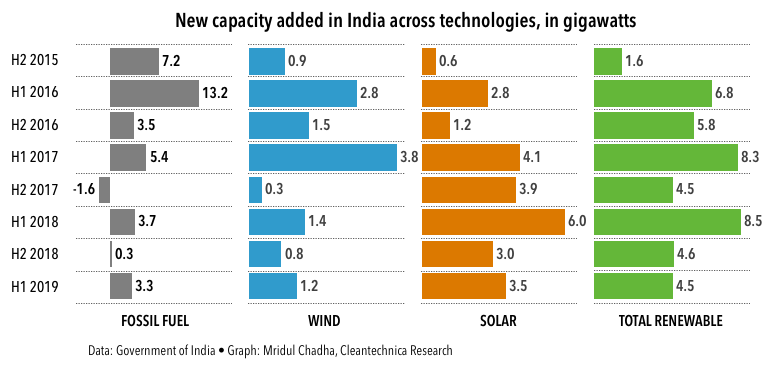India: Renewable Energy Dominates 1st Half Of 2019 With 58% Share In New Capacity
Jul 24, 2019 05:20 PM ET
Renewable energy technologies, especially wind and solar power, continued to lead all other technologies in new capacity added in the first half of 2019.
In the first half of this year, solar power technology had the largest contribution towards the new power generation capacity added in India. Of the 7.8 gigawatts of new capacity added between January and June 2019, 3.5 gigawatts came in the form of solar power projects. CleanTechnica Research took a closer look at the contribution of various power generation technologies.

Total Capacity Additions
India added a total of 7.8 gigawatts of power generation capacity in the first half (H1) of 2019. This is a sharp jump of 59% compared to the capacity added in H2 2018. The first half of each year usually sees a sharp uptick in new capacity addition as the period covers the end of the Indian financial year in March. Project developers race to commission any pending projects before the end of each financial year.
However, compared to H1 2018, the capacity addition is down 39%. Though, note that the share of individual technologies is relatively the same.
At the end of June 2019, India’s installed power capacity stood at 358.9 gigawatts.
Fossil Fuel-Based Capacity Additions
A total of 3.3 gigawatts of fossil fuel-based power generation capacity was added in H1 2019. The entire capacity in this category came from coal-based power plants, with no new capacity added in the diesel or gas-based segments. Additionally, the only major capacity addition within the coal-based power segment was added in March 2019 and virtually no net addition has been added since then.
The share of fossil fuel-based power in new capacity additions in H1 2019 was 42%, up sharply from just 10% in H2 2018. This share is the highest for the sector since H1 2016, when it constituted 65% of total capacity additions, with 13.2 gigawatts of coal-based power plants being commissioned out of the total 20.2-gigawatt capacity added in the country.
The capacity of fossil fuel-based technology (coal, gas, and diesel) was 226 gigawatts at the end of June 2019, with a share of just over 63% in the country’s total installed capacity.
Renewable Energy Capacity Additions
India managed to add 3.5 gigawatts of grid-connected solar power capacity during the six months ending June 2019. This is a marginal increase from the 3-gigawatt capacity added in H2 2018, but significantly lower than the all-time high of 6 gigawatts added in H1 2018.
In terms of share in new capacity added, solar power had a healthy share of 45%, beating fossil fuel-based capacity for a 4th consecutive 6-month period, but the technology’s share was the lowest since H1 2017.
In the wind power sector, 1.2 gigawatts of capacity was added, which constituted a share of 16% in the total capacity added in H1 2019. The capacity added increased marginally from 0.8 gigawatts in H2 2018, which was one of the lowest totals in a 6-month period.
At the end of June 2019, all renewable energy technologies had a total installed capacity of nearly 80.5 gigawatts, with a share of 22.4% in the total installed capacity. Other technologies (i.e., nuclear power and large hydro, which means a capacity greater than 25 megawatts) held a 14.5% share in the total installed capacity.
Also read
- SEF 2025 Kyiv: Forum on Innovation and the Restoration of Ukraine’s Energy Sector
- Innovation and Sustainability Arrive in Bucharest at the Country’s Largest Exhibition for Green Technologies and Solutions
- Energy risk management: How businesses can protect themselves from market volatility
- 2025 World Battery & Energy Storage Industry Expo (WBE)
- 2025 Solar PV & Energy Storage World Expo
